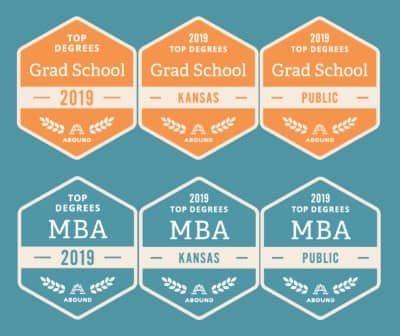Must-Have Strategies for Marketing to MBA Students
This article offers a comprehensive guide detailing four effective strategies for marketing to MBA students and growing your enrollment that you can begin implementing today.
It’s no secret that the value of an MBA has come under fire over the last few years. With the substantial financial and time cost of attending, whether part time or full, in person or online, many have become skeptical if earning one is a worthwhile attempt. And while an MBA program is not right for everybody, the degree can still provide massive value by offering real-world experience, a large network of professional contacts, and in-depth business knowledge.
Further, the benefits of attending a program will remain important as technology continues to change the shape of the workforce in the next couple of decades. As one article published by Stanford’s school of business cites, “by 2030, about half of today’s jobs will be gone…automation will perform many current blue-collar and white-collar jobs, while independent contractors will fill a large fraction of future positions.” What this means, of course, is that those who hone attributes exclusive to human beings—critical thinking, interpersonal skills, creative problem solving, and more—will be best equipped to meet the demands of tomorrow’s workforce. And this is precisely where a good MBA program can help.
Yet, although you might offer a high-quality MBA program, the major challenge can be how to use your marketing to convey this to you prospective students in an effective way. How you talk about your MBA program—and the story you’re telling prospective students—matters critically.
In this guide, we’ll review four must-have strategies to use in your MBA marketing and help increase your program’s enrollment:
Provide Reasons to Believe Your MBA Is Worth the Investment
Emphasize Real-World Business Experience
Bring Your MBA Program to Students
Become a High-Quality Content Marketer
Provide Reasons to Believe Your MBA Is Worth the Investment
Earning an MBA requires a substantial investment of money, time, and effort. This is why you must make a case for your MBA program by providing reasons to believe that the investment today will be worth it tomorrow.
This can be done in a number of ways. One of the most effective ways is to provide detailed statistics and data that relay the ROI of your program in a concise and easy-to-digest format. Remember, you’re speaking to business-savvy individuals who, like with any investment, expect to be able to make a rational consumer decision by weighing several variables.
The most compelling stats include the average salary for recent alumni, a list of organizations/businesses that are employing alumni, and the percentage of alumni who find full-time work in their desired field within six months after graduation. These stats provide clear, easy-to-understand information that paints a reasonable picture of what prospective students can expect should they enroll in your MBA program. The University of Delaware, for example, provides persuasive information on the median and mean salary of its graduates, the top employers for alumni, and more on a “Career Outcomes” webpage.

Of course, stats—no matter how impressive—can’t guarantee success for a given student. But by providing this information, you’re also revealing to them that you understand the seriousness of their decision. With transparent statistics, you’re essentially telling them, “Yes, this program requires a substantial sacrifice, but let us show you how hard we’re working to make it worthwhile for our students.”
This information is not always easy to come by, though. It can be difficult to keep tabs on alumni, which is why it’s important to build structures for doing so if you don’t already have them in place. You might not have the data you need today, but that shouldn’t keep you from planning to have it a few years down the road.
This might mean developing a process for obtaining personal email addresses from graduating students, recruiting faculty to help maintain ties with alumni, staying connected with organizations that are hiring alumni, and developing surveys that can be emailed to alumni with incentives—all of which ensure that you are collecting enough data to make up a statistically significant sample size. Remember, you don’t need to hear from every single alum, just a large enough group for it to be statistically significant.
 But even if you aren’t able to convey the most compelling stats, there are other things you can do. You should still be able to list a handful of organizations where alumni are working or some of the job titles alumni have acquired after earning their MBA. In this manner, you can still highlight reasons to believe while actively accruing more persuasive stats for later.
But even if you aren’t able to convey the most compelling stats, there are other things you can do. You should still be able to list a handful of organizations where alumni are working or some of the job titles alumni have acquired after earning their MBA. In this manner, you can still highlight reasons to believe while actively accruing more persuasive stats for later.
It’s also possible you already have more than you think. Reach out to professors and find out whether they have kept in touch with alumni and know how they’re doing professionally. Some professors have a lot to offer—the current job titles of former students, relationships with executives who think highly of your graduates, etc.—that you can tap into to boost your marketing efforts.
Aside from stats, there are a host of other ways to provide reasons to believe that your MBA is worth the investment. These include alumni spotlights (videos or written), highlighting the various program-offered networking events attended by industry leaders and executives, and quotes from recognizable employers speaking about the quality of your alumni. These constitute basic marketing practices in some ways, but the important thing is to be strategic. Are you reaching a wide net of students? Do your alumni testimonials spread a wide range of industries and types of students?
For example, you may have every industry represented, but what about a testimonial of a parent talking about how they balance school, family, and work? Or how about a testimonial from a CEO explaining specifically why she is impressed with employees who have graduated from your program? Instead of merely talking about networking events, how about offering a story about how a particular student found his or her job through a connection with an industry leader? Every program is going to list the basic offerings of their MBA—and it’s fine to do that as well—but you then need to back it up with reasons to believe through strategic testimonials, quotes, and stories.
Another fantastic example of how to provide reasons to believe when marketing to MBA students is through third-party endorsements in the form of awards and recognitions. These allow you to leverage what other people are saying about your MBA in order to make your marketing claims more believable. But this can be challenging when some of the well-known ranking and award systems favor the most prestigious, wealthy, and popular MBA programs in the country.
This is why an organization like Abound exists: to help quality MBA programs at smaller schools gain the recognition they deserve. The true measure of a program is found in its people and ideas, not its numbers and rankings. That’s why Abound evaluates MBA programs based on available career services to students, affordability, regional accreditation, flexible scheduling, faculty quality, time to completion, academic integrity, commitment to engaged learning, and more. In fact, Fort Hays State University found an increase in its graduate enrollment through the use of Abound’s third-party recognition badges on its website and print material to convey the quality of its programs. This is one way to feature third-party endorsements without falling into the traditional rankings trap.

It’s equally important when marketing to MBA students that you highlight how your program offers the chance to establish meaningful career-boosting relationships. Consider highlighting professors with years of leadership or entrepreneurship experience. Do you have mentorship programs that enable students to experience one-on-one coaching with a successful alum or professional connected to your school? How can you communicate the benefits that your career services offers, whether they be services to help foster networking skills, build a professional online presence, or conduct effective interviews?
Additionally, consider communicating how the relational benefits don’t end once students graduate. A quality MBA program can give alumni resources like these well beyond graduation through alumni events, professional networks, and other career opportunities. And these services are yet more examples of the lifelong benefits of earning an MBA. You can highlight this by finding alumni who are willing to chat with prospective students, answer practical questions, and share how their MBA has helped them.
The next step is to ensure that, no matter what reasons to believe you have primed in your arsenal, you’re actually getting them in front of prospective students with compelling design and organization. As an example, Santa Clara University’s Leavey School of Business hosts a well-designed and strategic landing page that highlights impressive companies in Silicon Valley at which their MBA alumni work. By listing organizations like Google, Twitter, and Netflix, they help prospective students understand how attending their program could lead to the sought-after ROI of working for a successful and respected brand.
While you should have your reasons to believe prominently displayed on your website and primary brochures, you should plan to disseminate them in other forms as well. You might convey this info through your email campaigns, or you could feature them on LinkedIn to a targeted demographic (paid or organic). What about mentioning them during info event presentations or during campus visits in an intentional way? You don’t want to bombard prospective students with this content, but make sure you have a strategy for gently reminding them through various touch points that your MBA is a worthwhile investment. Ultimately, the more they see your reasons to believe the more they’ll believe that what you’re saying about your program is true.
Emphasize Real-World Business Experience
One criticism levied at MBA programs is that these programs don’t actually prepare students for the challenges and shifting dynamics of the world of work. While theoretical knowledge is important, it’s necessary that your program also provides an opportunity for students to take that theoretical knowledge and engage it in real-world settings.
As an article from The EvoLLLution explains:
“Often, activities that connect students to the marketplace through experiential or action-based learning, co-ops, internships, global engagements or entrepreneurial activities (leveraging a lean launch-pad process toward enterprise creation, for example) are secondary or ancillary to the core academic experience. The core academic experience remains largely a function of discipline-based courses, taught through standard lectures or cases or other traditional pedagogies without consideration for how these methods connect students to the dynamism of the marketplace in which they will ultimately be competing.”

In other words, while theoretical knowledge remains a key aspect of MBA programs, there isn’t enough attention paid to providing students with real-word business experience. If prospective students are already unsure about the value of an MBA, then not being able to provide proof of tangible, experiential knowledge can make it even harder to convince them to make the investment.
There are a number of ways to offer this, including internships, coursework that offers real-world business projects, program capstone projects, summer partnership opportunities, student consulting projects, study abroad programs with international businesses, and more. Another way to offer real-world experience is to invite someone from a partnering organization or company to teach a course or part of a course. This article from The EvoLLLution shows just one example of how effective this industry connection can be:
“A company near my university sent two line managers to teach a junior-level operations management course. In a unique twist, the managers brought an actual production problem to their course and had students solve the issue. The company then implemented the best student plan and gave the three students on the winning project scholarships to finish their degrees. The company has now taught the course for two years and the students get real-world experience.”
Many programs do already offer opportunities like this. But the challenge isn’t so much in offering them in the first place (though that’s necessary should your program not be doing this already) but in communicating this to prospective students in compelling fashion.
You need to make it clear to students what these real-world business opportunities look like concretely and how they benefit them directly. For example, if you offer a work experience course, why not provide a robust case study on a project students have worked on? Imagine being able to review a case study on how actual MBA students drafted a digital marketing plan for a small agency, mapped out effective SOPs for the supply chain and logistics department of a company, or tapped an emerging market for a new product? Something like this is incredibly more compelling than a generic paragraph explaining that students will “work on a business project.”
 This is exactly what Point Loma Nazarene University did with a real-world business course that it offers in its Daytime MBA program. Through a landing page that serves as a detailed case study of a previous project, it maps out what the specific project entailed, the scope of the project, and how students worked to solve it. It also includes a video on the page highlighting the thoughts of both a participating student and the company executive who overlooked the project. Something like this clearly conveys to prospective students how exactly they might gain real-world business experience in your MBA program.
This is exactly what Point Loma Nazarene University did with a real-world business course that it offers in its Daytime MBA program. Through a landing page that serves as a detailed case study of a previous project, it maps out what the specific project entailed, the scope of the project, and how students worked to solve it. It also includes a video on the page highlighting the thoughts of both a participating student and the company executive who overlooked the project. Something like this clearly conveys to prospective students how exactly they might gain real-world business experience in your MBA program.
Too often, schools fail to provide clear accounts of real-world business experience, leaving students with nothing but an abstract and hard-to-imagine idea of what they might do if they were to enroll. Again, that’s why you need to provide specific details and examples. The University of Denver, for example, provides a detailed course schedule for both years of its MBA program to communicate a clear overview of how students will accrue real-world experience.
And there are several other ways to highlight real-world experience in more compelling ways when marketing to MBA students. You could craft a video that captures faculty, consultants, and students working with organizations on a given project. The University of Dallas, for example, used student testimonials to show how its Capstone Consulting Experience provides both practical experience alongside theoretical knowledge. You can feature quotes from managers or executives from organizations that have worked with current students in your program. And while it can be great to boast of partnerships with major companies, sometimes it’s the smaller organizations that allow real-world business experience and a leg up over the competition. Smaller organizations may have less “red tape” or siloed departments, allowing students to take on larger and higher-level projects.
By providing real and detailed examples of the kinds of experiences students in the past have had, you can paint a much more compelling picture of exactly how future students are going to be prepared for business success through your program when marketing to MBA students.
Bring Your MBA Program to Students
Another effective tactic for marketing to MBA students is to tailor your program for their convenience. The most obvious way of doing this is to offer online or online/on-site hybrid programs that are flexible and conducive to a range of student schedules. This makes it easier for those with jobs, families, or both to complete your program. It also allows you to cast a wider net for potential students, as your program’s marketing is no longer limited by geography.
An equally worthwhile way to bring your MBA program to students is to offer the program onsite at their places of employment. This can be an incredibly effective strategy for marketing to MBA students and increasing enrollment. That said, it also requires forging partnerships with local organizations that align with your program’s curriculum and objectives.
There are three primary types of partnerships, the first of which doesn’t require that you bring anything onsite to your partnering organization. Rather, it is to offer a discount to your MBA program. You form a relationship with an organization and agree to offer its employees some type of discount on tuition for your program (whether it’s onsite at your university’s location or online). This requires very little resources on your part and is a great way to reach a new audience who are now incentivized to take your specific MBA program.
 The second strategy is to offer one-off courses, lectures, or workshops to employees at your partner organizations. This might be as simple as a free two-hour workshop on a relevant business topic at the organization’s location. Or it could be a full semester course on finance or marketing onsite that would result in program credits for employees enrolled in the course (credits they could then transfer over should they decide to enroll in your full MBA program).
The second strategy is to offer one-off courses, lectures, or workshops to employees at your partner organizations. This might be as simple as a free two-hour workshop on a relevant business topic at the organization’s location. Or it could be a full semester course on finance or marketing onsite that would result in program credits for employees enrolled in the course (credits they could then transfer over should they decide to enroll in your full MBA program).
The key with this strategy is that it helps you acquire leads to market to: potential students of your MBA program who have already participated in your on-site offerings. Of course, this is why it’s important that these offerings provide real value. If individuals have a positive experience with the professor who taught a workshop or are impressed by the depth of knowledge conveyed in a lecture series, they will already have a positive association with your school if or when they begin considering MBA programs.
The last and most robust strategy for marketing to MBA students through organizational partnerships is to offer an entire MBA program onsite at their employer. It’s one thing for employees to see that they can take a program for a discount, but it’s another thing altogether for them to be encouraged by their colleagues and supervisors to take a full program offered at the very same place they work.
You have to make sure these efforts result in an ROI for both your institution and the partnering organization. First, you need to have enough individuals enrolled each semester to offset the costs of providing the on-site program. Secondly, organizations need to feel that their employees are better able to solve business challenges directly because of your program. Are the employees enrolled in your program acquiring skills that they can apply to the business itself? Are they bringing forth novel solutions to their workplace? Are they better equipped to meet the needs of a changing economy within their industry?
It’s also important to work with stakeholders at the organizations to help them market your programs. Whether you’re offering a discounted tuition plan of an actual on-site MBA program, your biggest advocates are the stakeholders at these organizations who can encourage their employees to engage your offerings. This means supporting them as much as possible when marketing to MBA students.
Some examples of support include marketing materials—brochures, flyers, handouts—customized for that given employer and the program you’re offering them, which you can ask stakeholders to make available in the office. You can also ask whether they would allow you to email their employees, in which case you can develop an effective and customized email strategy. Or you can offer to write an email for a stakeholder to send themselves, detailing the benefits and highlights of your MBA program and encouraging employees to enroll.
 There are a number of things that you can do, but the key is to make it as easy as possible for your organizational partners to communicate the benefits of your MBA program to their employees. And the best way to do this is to convince stakeholders that having their students take the program is just as beneficial to them as it is to your institution.
There are a number of things that you can do, but the key is to make it as easy as possible for your organizational partners to communicate the benefits of your MBA program to their employees. And the best way to do this is to convince stakeholders that having their students take the program is just as beneficial to them as it is to your institution.
Lastly, there are other ways to partner with an organization beyond the three strategies discussed above. For example, Northeastern University has a partnership with IBM where the university recognizes IBM digital badge credentials (which the company gives out to its employees) toward graduate degree programs and certificates at the university. This strategy encourages IBM employees to take a program at Northeastern since they already have credits that the school will recognize (and could therefore complete a program for less money and less time than at another school).
The point is that forging partnerships with local employer organizations is becoming a necessary strategy for marketing to MBA students and distinguishing your program from the competition.
Become a High-Quality Content Marketer
The most compelling MBA programs reveal their business knowledge and insight by showing it to prospective students—not just telling them about it. And this happens by becoming a high-quality content marketer. There are several ways to do this when marketing to MBA students, from providing webinars and free courses to creating and sharing white papers.
To start, it’s worth considering an example of a content marketing strategy that targets a particular section of the sales funnel. For those unfamiliar with the concept of the sales funnel, this refers to the various stages that prospective consumers are in during their buyer journey. The funnel is usually broken down into three levels (top, middle, and bottom) with the chance for further distinction within each category (which is especially helpful for the different prospects of an MBA program).

A top funnel content marketing strategy would be aimed at producing and offering content to people at the very beginning of the buyer journey (e.g. business professionals who are not actively considering an MBA or are just starting to think about it). A middle funnel strategy would be aimed at those who have indicated that they are considering enrolling in an MBA program (signed up to take the GMAT, requested info from your website, etc.). And a bottom funnel strategy would be aimed at those who have indicated a strong interest in your specific program (applicants, individuals who have made consistent contact with your school, etc.).
With those clarifications, let’s now consider a middle funnel content marketing strategy. We all know the MBA application process requires a lot of work for prospective students (crafting personal statements, studying and taking the GMAT, etc.). Therefore, a middle funnel approach could be to lessen the burden of the application process: to help students wade through options and apply to the right MBA programs. In order to do this through your content efforts, you could provide a webinar detailing what counselors are looking for from student applications. Can you work with a counselor or two and have them offer prospective students a free 45-minute webinar?
One extremely effective approach is to offer a free online or in-person GMAT test-prep course. This requires a fair amount of resources (finding and paying an instructor, providing class materials, securing a physical location if offered in person, etc.). But it can give you a pool of very qualified student leads. And if your GMAT test-prep course is of high quality—which it should be if you decide to offer one—then it can send a very positive message about the quality of your program to everyone who participates. Even if you only get two or three enrolled students out of a class of fifty, that can still justify the few thousands of dollars it may cost to offer the course.
Of course, there are several other middle funnel content marketing approaches that require much fewer resources that can be just as effective. This includes white papers about what to look for in an MBA program, an ebook unpacking the merits of concentrating on a specific business discipline in a program, or a blog highlighting the pros and cons of going back to get an MBA, all of which can help students make a decision that’s right for them.
We can also apply this strategy to address people at the top of the funnel. Although this audience hasn’t yet indicated a clear interest in earning an MBA, they should be likely to be interested (working within a certain business-related profession, having earned a bachelor’s degree, etc.). A top funnel approach naturally entails a longer-term strategy. But content tailored for this audience can still be quite effective.
 But what kind of content is good for a top funnel strategy? Content that business-minded individuals would find useful for their own professional careers. This could be a podcast that features your MBA faculty talking about the latest market trends. It could be an event that features an alum speaking about a current industry challenge. It could be a weekly blog that unpacks why certain businesses and organizations have been successful through their marketing strategies. Or it could be an ebook providing valuable insight on how to negotiate in the workplace. The possibilities are endless.
But what kind of content is good for a top funnel strategy? Content that business-minded individuals would find useful for their own professional careers. This could be a podcast that features your MBA faculty talking about the latest market trends. It could be an event that features an alum speaking about a current industry challenge. It could be a weekly blog that unpacks why certain businesses and organizations have been successful through their marketing strategies. Or it could be an ebook providing valuable insight on how to negotiate in the workplace. The possibilities are endless.
Ultimately, the goal is to establish your institution as an authority that has helpful and valuable information to share for those interested in business-related topics. Not only will this introduce your MBA program to those consuming your content, but it will create a positive impression of your program in their minds. If your content is valuable, well-researched, and informative, then they’ll most likely expect your MBA program to be of high-quality as well.
Ideally, you should have a content marketing strategy that includes top, middle, and bottom funnel content offerings. If you are just getting started and have somewhat limited resources, it would be worth doing a content audit to determine where you have the largest gaps along the buyer journey. For example, if you seem to be accruing a fair amount of leads but aren’t converting many of them into applicants, then it’s worth starting with middle funnel content to address this audience.
Regardless of what type of content you’re focusing on, it’s imperative that you have a lead nurturing strategy in place. You may offer a fantastic podcast on entrepreneurship or a revelatory ebook on management consulting, but if you aren’t encouraging readers to remain engaged with your institution, you won’t ever turn them into enrolled students.
This means you must first make sure that you’re capturing audience emails to add to your list when you offer a new piece of content on a landing page or on your website. It means you should send out regular emails that include both helpful and valuable information as well as details about your program and calls-to-actions (CTAs) for readers to take the next step (e.g. attend an info event, start an application, email a counselor, etc.). Not every email needs to have a CTA as long as each one is offering value that encourages your audience to engage and not unsubscribe. But CTAs should still be strategically placed throughout your email campaign as to nurture readers actively down the sales funnel.

Lastly, it’s important to make sure your content marketing efforts are getting results. This means that, if you’re generating a podcast to increase your leads or a webinar to turn them into applicants, you’re regularly making sure this content is actually achieving these goals. It’s not necessary for every single piece of content to correlate to a direct return on investment (some pieces can help with institutional branding and reputation), but you should develop key performance indicators (KPIs) that you can use to evaluate your overall effectiveness. From measuring web visits and email subscribers for a new blog to recording new leads or applicants generated by a free GMAT test-prep course, being able to determine what is working (and what isn’t) will allow you to keep adjusting your content strategy for marketing to MBA students.
Ultimately, content marketing is one of the most compelling ways to prove—and not just tell—your audience that your institution is committed to the success of students. And when it comes to preparing them for the dynamic world of business, MBA students will believe that your program will deliver because they’ve already seen you do it through consistent, valuable, and high-quality content.




